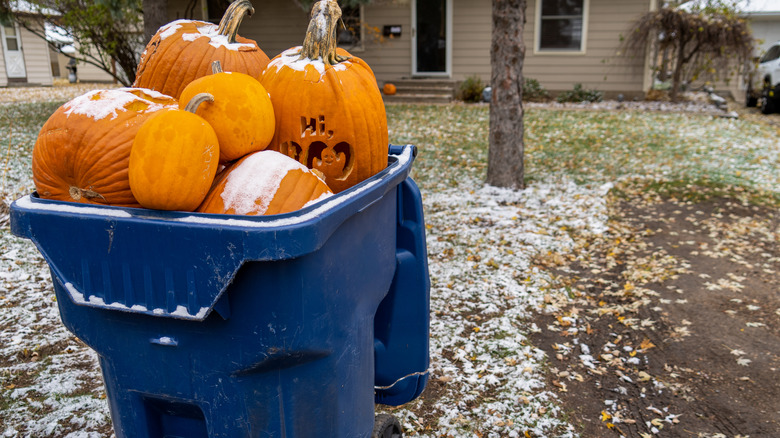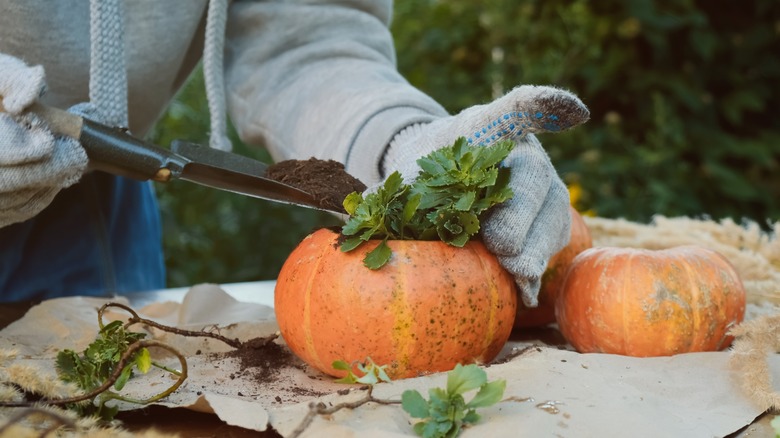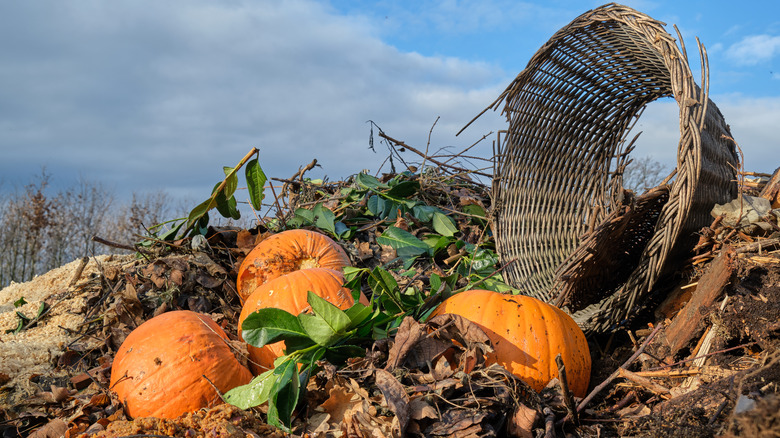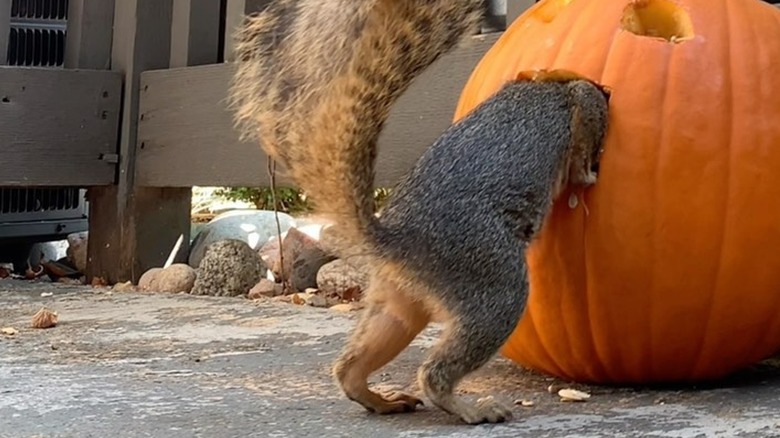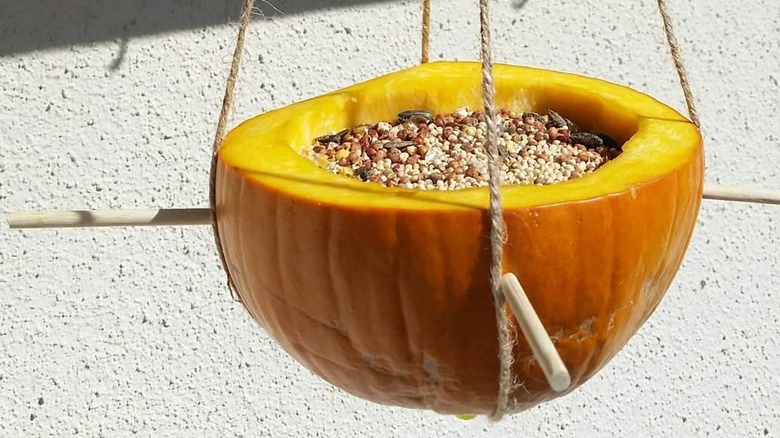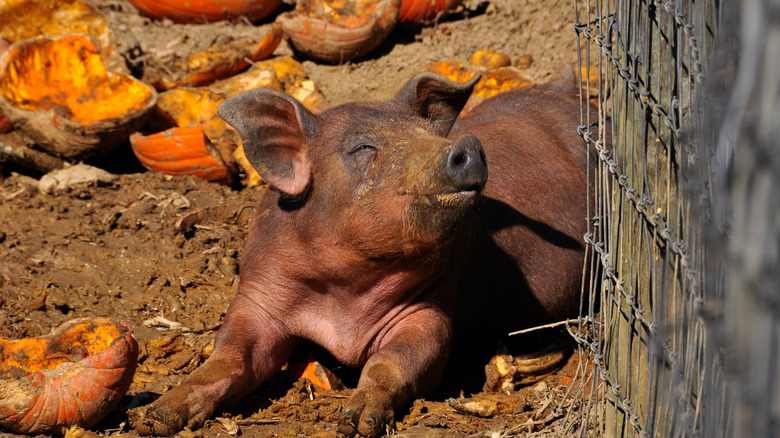Ways To Repurpose Your Old Pumpkin, Other Than Tossing It In The Trash
After Halloween, your grim-grinning jack-o-lanterns have traded in their spooky smiles for a rather smooshed and saggy expression that looks more like a retirement home for aging pumpkins and less a spooky or autumnal vibe. Instead of sending your defunct gourds to the ill-fated garbage can, your old pumpkins can actually serve as a food source for wildlife, worms, and even soil microbes. While it's always fun to make a pie from scratch or harvest seeds to roast as a snack, there are more than a few great ways to recycle your old pumpkins that won't harm the earth.
Every year in the United States, around 1.3 billion pounds of pumpkins call the landfill their final resting place. Like most organic products that call these massive garbage patches their home, these gourds produce methane gas, which is responsible for at least 20 percent of global carbon emissions. Pumpkins don't belong in landfills. They bring us so much joy every fall, so don't you think it's a great idea to let them live out their days doing something that benefits the planet?
Turn it into a festive (yet temporary) planter
Turning a pumpkin into a planter involves a few simple steps. To begin, you'll need a large pumpkin, a terra cotta or plastic pot, potting soil, your favorite annual flowers, and a garden trowel. Start by carving an opening in the pumpkin's top slightly smaller than the pot you're going to work with. Next, thoroughly clean out all the pumpkin guts so there's nothing left inside. It's recommended that you create small holes in the base of your pumpkin to act as drainage.
Once the pumpkin is ready, your plant pot should snugly fit inside. You can adjust the height by using crumpled-up newspaper or tin foil underneath the pot. After planting your greenery or flowers in the pot, reinsert it into the pumpkin. As fall transitions into winter, you can plant the foliage, sans pumpkin, directly in the ground. Alternatively, you can remove the pot and plant the flowers directly in the gourd, then place the pumpkin in the ground so that it will naturally decompose and fertilize the soil.
Create pumpkin compost
Pumpkin composting is pretty simple. You just want to be sure to move the guts so you don't accidentally create a pumpkin patch in your compost pile. Before you toss your gourd into your deterioration station, be sure to remove any synthetic elements like wax, paint, stickers, or other non-biodegradable decorations. Because they're mostly water, pumpkins decompose pretty quickly.
But if you want them to break down faster, it's best to cut them into pieces. This will substantially expedite the composting process. Once your pumpkin is broken into fragments, cover it with loose leaves, making sure you're keeping equally balanced browns (leaves) and greens (pumpkin pieces) so that your compost will all break down evenly. Just don't overdo the leaves since you'll need enough air flow and sunlight to turn them into mulch successfully.
Lastly, just let nature do its thing. Over time, your pumpkin will naturally decompose back from where it once came. If you're lucky, you might even spot some worms or insects noshing down on this organic feast. So spooky.
Feed your backyard wildlife
Your old Halloween pumpkin also makes the perfect snack for neighborhood wildlife. Once you're done displaying your pumpkins, cut them up into fourths and place the pieces around your yard. Depending on where you live, deer, rabbits, raccoons, squirrels, and other opportunivores will make sure they won't go to waste.
For a creative touch, you can also add an assortment of fresh produce like carrots and apples to make them a bit more enticing. Try making a mixed plate of apples, pears, and pumpkins as a food offering for burrowing animals and flying friends. Larger pumpkin pieces can be cut up and placed in secluded areas of your yard. These can act as food for night-flying moths and insects that survive off plant blood.
Don't toss your pumpkin seeds. Instead, add them to your offering plate. Just make sure they're goop-free and have been allowed to fully dry out. Your seeds can be stored in your freezer for up to three months.
Make a pumpkin birdfeeder
If you're enjoying pumpkin-spiced lattes, don't you think your feathered friends should enjoy a little pumpkin treat themselves? There are a few different ways to turn your pumpkin into a bird feeder. The first is easiest and requires a medium-sized pumpkin, a few small sticks, twine or rope, a drill, and, of course, bird seed.
Start by cutting the pumpkin in half and removing the seeds, keeping the shell about half an inch thick. Make four small holes across from one another and push the sticks inside. Attach a knotted rope to the bottom of the pumpkin and hang the feeder at your desired location. Finally, fill it with birdseed.
The second method also uses a medium-sized pumpkin, but you'll need a cutting tool to finish the job. Make sure your gourd is free from the slimy innards and scooped clean. Next, carve an assortment of different-sized holes. These entry points should ensure easy access for different types of birds but also offer a sense of security and comfort.
With both methods, you'll want to immerse or spray your pumpkin in a mild bleach solution, which will help deter mold growth. Sprinkling bird seed seeds on the cut edges and around the feeder helps birds discover the food source.
Donate it back to a farm
Don't want to deal with the pumpkins yourself? See if you can donate them to zoos, animal shelters, or farms. They'll be grateful for the compost material or animal snacks. Zoos frequently offer pumpkins to animals as a unique form of enrichment, bringing novelty and interaction to their environment. From otters using pumpkins as playful "pool toys" to primates discovering ways to access the food inside, animals enjoy the novelty and challenges that pumpkins bring.
Pumpkins are utilized diversely in zoos, serving as intriguing hiding spots, prey-hunting grounds, or even toys for different species. Donating your clean pumpkin doesn't just keep it from ending up in a landfill and producing greenhouse gas emissions — it also acts as nourishment and gives animals something to play with.
Some farms and animal sanctuaries gladly accept donated pumpkins for food and entertainment. If you're unsure about handling your pumpkins, consider donating them to zoos, farms, or community gardens, where they will be appreciated for their contribution to animal well-being or composting efforts.
